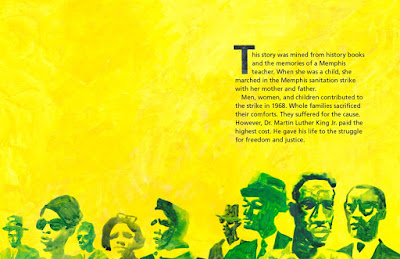 |
| Coretta Scott King Award |
The Coretta Scott King Book Awards are a continued source of inspiration for me and the schools I serve. Each year, these awards are given to authors and illustrators for books that honor African American culture and universal human values. Today, I would like to share the winning books with you. As the award
website states,
"The award commemorates the life and work of Dr. Martin Luther King, Jr., and honors his wife, Mrs. Coretta Scott King, for her courage and determination to continue the work for peace and world brotherhood."
2015 CSK Illustrator Award:
Firebird, illustrated by Christopher Myers and written by Misty Copeland. In this stirring, beautiful picture book, Copeland creates a conversation between a young girl who dreams of dancing and herself as a professional ballerina (
my full review) Myers illustrations are full of vibrant, saturated colors and help children visualize a story as they listen to Copeland's poetic text.
I read
Firebird today with 2nd graders -- Jeehyun said, "It's like it was showing the young girl's life cycle," as she grew up and followed her dreams. I smiled, as we thought back to Jeehyun in kindergarten and wondered what advice she would have to herself as she was just starting school. It was a magical moment to share. Inspiring, for ages 6-10.
2015 CSK Illustrator Honor Awards:
Josephine: The Dazzling Life of Joesphine Baker, illustrated by Christian Robinson and written by Patricia Hruby Powell. I
adore this beautiful biography that Patricia Hruby Powell & Christian Robinson created celebrating Baker's life and work (
see my full review). Christian Robinson captures Josephine's movement and playfulness with his gorgeous acrylic illustrations. Savor this long picture book biography over several sittings -- and notice how the pictures and words play off each other. For ages 8-12.
Little Melba and Her Big Trombone, illustrated by Frank Morrison and written by Katheryn Russell-Brown. As
Kirkus writes, "Bewitched by the rhythms of jazz all around her in Depression-era Kansas City, little Melba Doretta Liston longs to make music in this fictional account of a little-known jazz great." Kids love the exaggerated illustrations that brim with humor, sass and verve--just like I imagine Melba's trombone playing did. A great picture book biography, for ages 4-8.
2015 CSK Author Award:
Brown Girl Dreaming, by Jacqueline Woodson, is a moving, evocative memoir in verse that paints a picture of what it was like to grow up black and female in the 1960s and 1970s (see
my full review). This book was especially meaningful to several of my African American students, especially girls, who could relate to Jackie's experiences. This powerful book will now be decorated with four medals: the National Book Award, the Newbery Honor, the Coretta Scott King Award, and the Sibert Award for nonfiction. Excellent and outstanding in so many ways, best suited for ages 10-14.
2015 CSK Author Honor Awards:
The Crossover, by Kwame Alexander, was recognized for its portrayal of a close-knit African American family, loving and supportive but also rife with tension between the brothers. As you know, my students are **
huge** fans of
The Crossover. As I said to a friend when I first read it, I love how the characters' African American identity is an important part of the book, but not an issue in the story -- it's just part of who they are. Don't BOTH of those medals look fantastic on this cover? Fantastic for ages 9-14.
How I Discovered Poetry, by Marilyn Nelson, is memoir in verse that is based on Nelson's experiences growing up as a daughter of one of the first African-American career officers in the Air Force during the 1950s.
Publisher's Weekly calls this "an intimate perspective on a tumultuous era and an homage to the power of language." To learn more, listen to this
NPR interview with Nelson. I have not read this or shared it with students, so I'm not quite sure if it's best suited for ages 12 and up, or would be a good fit for our 5th graders.
How It Went Down, by Kekla Magoon, is a gripping novel for teens that is undeniably relevant to issues our society is grappling with around the country. As
Publisher Weekly writes, Magoon "offers multiple, contradictory perspectives on the shooting of an African-American youth. No one disputes that 16-year-old Tariq Johnson was shot on the street by Jack Franklin, a white gang member, but the motives of both killer and victim remain fuzzy, as do the circumstances surrounding the shooting." While I have not read this, I am a big fan of Magoon's previous work and know this will be an intense and full of raw emotions, for ages 14 and up.
2015 John Steptoe Award for New Talent:
When I Was the Greatest, by Jason Reynolds. I have not read this, but friends are raving about this engaging story of urban teens Ali, Noodles and Needles. As the
award committee writes, "In an authentic contemporary voice, Reynolds focuses on the importance of family, the acceptance of responsibility and the obligations of friendship and portrays a likeable teenager learning how to be a good man." Recommended for ages 12 and up.
Please seek out and share these books with kids in your life. They are each truly special. Early review copies were kindly sent by the publishers Penguin, Houghton Mifflin Harcourt, Lee & Low, and Chronicle Books. We have purchased additional copies for our school library and classrooms, and we will continue purchasing more for gifts. If you make a purchase using the Amazon links on this site, a small portion goes to Great Kid Books. Thank you for your support.
©2015 Mary Ann Scheuer, Great Kid Books

















































